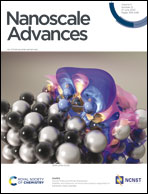Amine-assisted catechol-based nanocoating on ultrasmall iron oxide nanoparticles for high-resolution T1 angiography†
Abstract
Surface engineered iron oxide nanoparticles (IONPs) with catecholic ligands have been investigated as alternative T1 contrast agents. However, complex oxidative chemistry of catechol during IONP ligand exchange causes surface etching, heterogeneous hydrodynamic size distribution, and low colloidal stability because of Fe3+ mediated ligand oxidation. Herein, we report highly stable and compact (∼10 nm) Fe3+ rich ultrasmall IONPs functionalized with a multidentate catechol-based polyethylene glycol polymer ligand through amine-assisted catecholic nanocoating. The IONPs exhibit excellent stability over a broad range of pHs and low nonspecific binding in vitro. We also demonstrate that the resultant NPs have a long circulation time (∼80 min), enabling high resolution T1 magnetic resonance angiography in vivo. These results suggest that the amine assisted catechol-based nanocoating opens a new potential of metal oxide NPs to take a step forward in exquisite bio-application fields.



 Please wait while we load your content...
Please wait while we load your content...